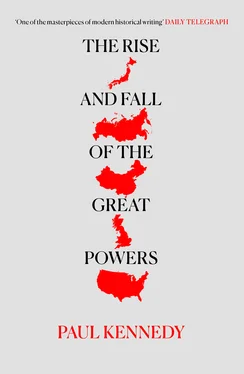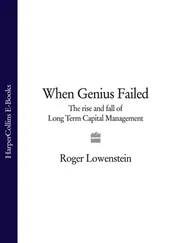The best illustration of this relative French weakness occurred in the years following the American Revolutionary War. It had hardly been a glorious conflict for the British, who had lost their largest colony and seen their national debt rise to about £220 million; but since those sums had chiefly been borrowed at a mere 3 per cent interest, the annual repayments totalled only £7.33 million. The actual costs of the war to France were considerably smaller; after all, it had entered the conflict at the halfway stage, following Necker’s efforts to balance the budget, and for once it had not needed to deploy a massive army. Nonetheless, the war cost the French government at least a billion livres, virtually all of which was paid by floating loans at rates of interest at least double that available to the British government. In both countries, servicing the debt consumed half the state’s annual expenditures, but after 1783 the British immediately embarked upon a series of measures (the Sinking Fund, a consolidated revenue fund, improved public accounts) in order to stabilize that total and strengthen its credit – the greatest, perhaps, of the younger Pitt’s achievements. On the French side, by contrast, large new loans were floated each year, since ‘normal’ revenues could never match even peacetime expenditures; and with yearly deficits growing, the government’s credit weakened still further.
The startling statistical consequence was that by the late 1780s France’s national debt may have been almost the same as Britain’s – around £215 million – but the interest payments each year were nearly double, at £14 million. Still worse, the efforts of succeeding finance ministers to raise fresh taxes met with stiffening public resistance. It was, after all, Calonne’s proposed tax reforms, leading to the Assembly of Notables, the moves against the parlements , the suspension of payments by the treasury, and then (for the first time since 1614) the calling of the States General in 1789 which triggered off the final collapse of the ancien régime in France. 20 The link between national bankruptcy and revolution was all too clear. In the desperate circumstances which followed, the government issued ever more notes (to the value of 100 million livres in 1789, and 200 million in 1790), a device replaced by the Constituent Assembly’s own expedient of seizing church lands and issuing paper money on their estimated worth. All this led to further inflation, which the 1792 decision for war only exacerbated. And while it is true that later administrative reforms within the treasury itself and the revolutionary regime’s determination to know the true state of affairs steadily produced a unified, bureaucratic, revenue-collecting structure akin to those existing in Britain and elsewhere, the internal convulsions and external overextension that were to last until 1815 caused the French economy to fall even further behind that of its greatest rival.
This problem of raising revenue to pay for current – and previous – wars preoccupied all regimes and their statesmen. Even in peacetime, the upkeep of the armed services consumed 40 or 50 per cent of a country’s expenditures; in wartime, it could rise to 80 or even 90 per cent of the far larger whole! Whatever their internal constitutions, therefore, autocratic empires, limited monarchies, and bourgeois republics throughout Europe faced the same difficulty. After each bout of fighting (and especially after 1714 and 1763), most countries desperately needed to draw breath, to recover from their economic exhaustion, and to grapple with the internal discontents which war and higher taxation had all too often provoked; but the competitive, egoistic nature of the European states system meant that prolonged peace was unusual and that within another few years preparations were being made for further campaigning. Yet if the financial burdens could hardly be carried by the French, Dutch, and British, the three richest peoples of Europe, how could they be borne by far poorer states?
The simple answer to this question was that they couldn’t. Even Frederick the Great’s Prussia, which drew much of its revenues from the extensive, well-husbanded royal domains and monopolies, could not meet the demands of the War of the Austrian Succession and Seven Years War without recourse to three ‘extraordinary’ sources of income: profits from debasement of the coinage; plunder from neighbouring states such as Saxony and Mecklenburg; and, after 1757, considerable subsidies from its richer ally, Britain. For the less efficient and more decentralized Habsburg Empire, the problems of paying for war were immense; but it is difficult to believe that the situation was any better in Russia or in Spain, where the prospects for raising monies – other than by further squeezes upon the peasantry and the underdeveloped middle classes – were not promising. With so many orders (e.g. Hungarian nobility, Spanish clergy) claiming exemptions under the anciens régimes , even the invention of elaborate indirect taxes, debasements of the currency, and the printing of paper money were hardly sufficient to maintain the elaborate armies and courts in peacetime; and while the onset of war led to extraordinary fiscal measures for the national emergency, it also meant that increasing reliance had to be placed upon the western European money markets or, better still, direct subsidies from London, Amsterdam, or Paris which could then be used to buy mercenaries and supplies. Pas d’argent, pas de Suisses may have been a slogan for Renaissance princes, but it was still an unavoidable fact of life even in Frederician and Napoleonic times. 21
This is not to say, however, that the financial element always determined the fate of nations in these eighteenth-century wars. Amsterdam was for much of this period the greatest financial centre of the world, yet that alone could not prevent the United Provinces’ demise as a leading power; conversely, Russia was economically backward and its government relatively starved of capital, yet the country’s influence and might in European affairs grew steadily. To explain that seeming discrepancy, it is necessary to give equal attention to the second important conditioning factor, the influence of geography upon national strategy.
Because of the inherently competitive nature of European power politics and volatility of alliance relationships throughout the eighteenth century, rival states often encountered remarkably different circumstances – and sometimes extreme variations of fortune – from one major conflict to the next. Secret treaties and ‘diplomatic revolutions’ produced changing conglomerations of powers, and in consequence fairly frequent shifts in the European equilibrium, both military and naval. While this naturally caused great reliance to be placed upon the expertise of a nation’s diplomats, not to mention the efficiency of its armed forces, it also pointed to the significance of the geographical factor. What is meant by that term is not merely such elements as a country’s climate, raw materials, fertility of agriculture, and access to trade routes – important though they all were to its overall prosperity – but rather the critical issue of strategical location during these multilateral wars. Was a particular nation able to concentrate its energies upon one front, or did it have to fight on several? Did it share common borders with weak states, or powerful ones? Was it chiefly a land power, a sea power, or a hybrid – and what advantages and disadvantages did that bring? Could it easily pull out of a great war in central Europe if it wished to? Could it secure additional resources from overseas?
The fate of the United Provinces in this period provides a good example of the influences of geography upon politics. In the early seventeenth century it possessed many of the domestic ingredients for national growth – a flourishing economy, social stability, a well-trained army, and a powerful navy; and it had not then seemed disadvantaged by geography. On the contrary, its river network provided a barrier (at least to some extent) against Spanish forces, and its North Sea position gave it easy access to the rich herring fisheries. But a century later, the Dutch were struggling to hold their own against a number of rivals. The adoption of mercantilist policies by Cromwell’s England and Colbert’s France hurt Dutch commerce and shipping. For all the tactical brilliance of commanders like Tromp and de Ruyter, Dutch merchantmen in the naval wars against England had either to run the gauntlet of the Channel route or to take the longer and stormier route around Scotland, which (like their herring fisheries) was still open to attack in the North Sea; the prevailing westerly winds gave the battle advantage to the English admirals; and the shallow waters off Holland restricted the draught – and ultimately the size and power – of the Dutch warships. 22 In the same way as its trade with the Americas and Indies became increasingly exposed to the workings of British sea power, so, too, was its Baltic entrepôt commerce – one of the very foundations of its early prosperity – eroded by the Swedes and other local rivals. Although the Dutch might temporarily reassert themselves by the dispatch of a large battle fleet to a threatened point, there was no way in which they could permanently preserve their extended and vulnerable interests in distant seas.
Читать дальше












